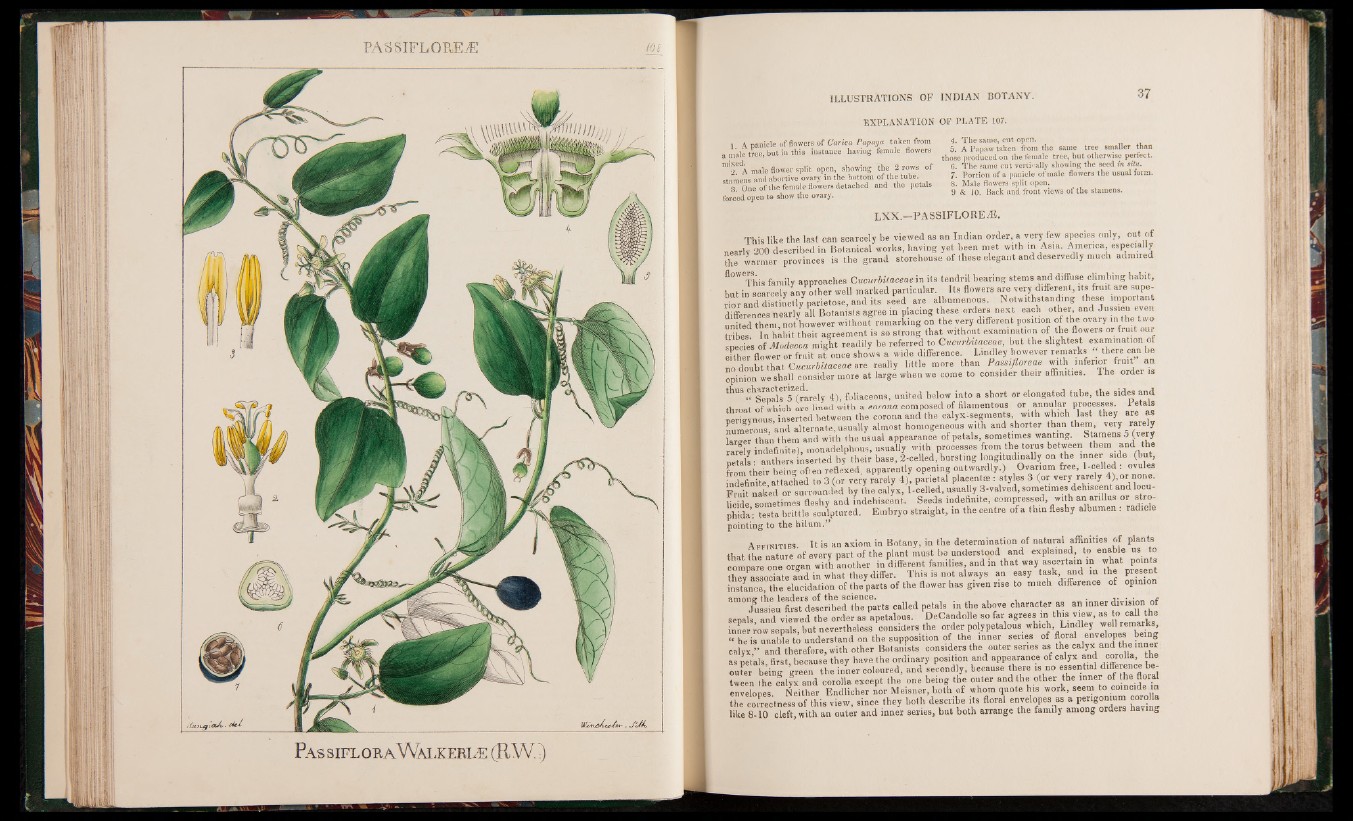
WAAi^yicj ~. -fi/h
Pas s ifl oraW j .keriæ (RW.:)
EXPLANATION OF PLATE 107.
1 A panicle of flowers o f Carica Papaya taken from
a male tree, but in this instance having female flowers
m^ € A male flower split open, showing the 2 rows of
stamens and abortive ovary in the bottom of the tube.
8. One of tbe female flowers detached and the petals
forced open to show the ovary.
4. The same, cut open.
5. A Papaw taken from the same tree smaller than
those produced on the female tree, but otherwise perfect.
6. The same cut vertically showing the seed in situ.
7. Portion of a panicle of male flowers the usual form.
8. Male flowers split open.
9 & 10. Back and front views of the stamens.
LXX.—PASSIFLOREÆ.
This like the last can scarcely be viewed as an Indian order, a very few species only, out of
nearly 200 described in Botanical works, having yet been met with in Asia. America especially
the warmer provinces is the grand storehouse of these elegant and deservedly much admired
flowers. approaciles Cucurbitaceaem its tendril bearing stems and diffuse climbing habit,
but in scarcely any other well marked particular. Its flowers are very different, its fruit are supe-
rior and distinctlyparietose, and its seed are albumenous. Notwithstanding these important
differences nearly all Botanists agree in placing these orders next each other, and Jussieu even
united them, not however without remarking on the very different position of the ovary in the two
tribes. In habit their agreement is so strong that without examination of the flowers or fruit our
species of Modecca might readily be referred to Cucurbit aceae, but the slightest examination of
either flower or fruit at once shows a wide difference. Lindley however remarks there can be
no doubt that Cucurbitaceae are really little more than Passifloreae with inferior fruit an
opinion we shall consider more at large when we come to consider their affinities. The order is
thus charactenzed. f0Haceous, united below into a short or elongated tube, the sides and
throat of which are lined with a corona composed of filamentous or anna1?1; processes. Petals
neriwnous, inserted between the corona and the calyxisegments with which last they are as
numerous, and alternate, usually almost homogeneous with and shorter than them, very rarely
larger than them and with the usual appearance of petals, sometimes wanting. Stamens 5 (very
rarely indefinite), monadelphous, usually with processes from the torus between them and^ the
nctals • anthers inserted by their base, 2-celled, bursting longitudinally on the inner side (but
from their being often reflexed, apparently opening outwardly.)' Ovarium free, 1-celled: ovules
indefinite attached to 3 (or very rarely 4), parietal placenta;: styles 3 (or very rarely 4), or none.
Fruit naked or surrounded by the calyx, l-celled, usually 3-valved, sometimes dehiscent and locu-
licide sometimes fleshy and indehiscent. Seeds indefinite, compressed, with an anllus or stro-
phida: testa brittle sculptured. Embryo straight, in the centre of a thin fleshy albumen : radicle
pointing to the hilum.’*
A f fin it ie s. It is an axiom in Botany, in the determination of natural affinities of plants
that the nature of every part of the plant must be understood and explained, to enable us to
compare one organ with another in different families, and m that way ascertain in what points
thevPassociate and in what they differ. This is not always an easy task, and in the present
instance, the elucidation of the parts of the flower has given rise to much difference of opinion
am0I I d e S L l r ! l U l ehneCpe;rts called petals in the above character as an inner division of
sepals, and viewed the order as apetalous. DeCandolle so far agrees in this view, as ocalUhe
inner row sepals, but nevertheless considers the order polypetalous which Lindley well remarks
1 he is unaWe to understand on the supposition of the inner series of floral envelopes being
calyx,” and therefore, with other Botanists considers the outer senes as the calyx
as petals first, because they have the ordinary position and appearance of calyx and corolla, the
outer being green the inner coloured, and secondly, because there is no essential difference between
the calyx and corolla except the one being the outer and the other the inner of the floral
envelopes Neither Endlicher nor Meisner, both of whom quote his work, seem to coincide in
the correctness of this view, since they both describe its floral envelopes as a pengonmm corolla
like 8-10 cleft, with an outer and inner series, but both arrange the family among orders having